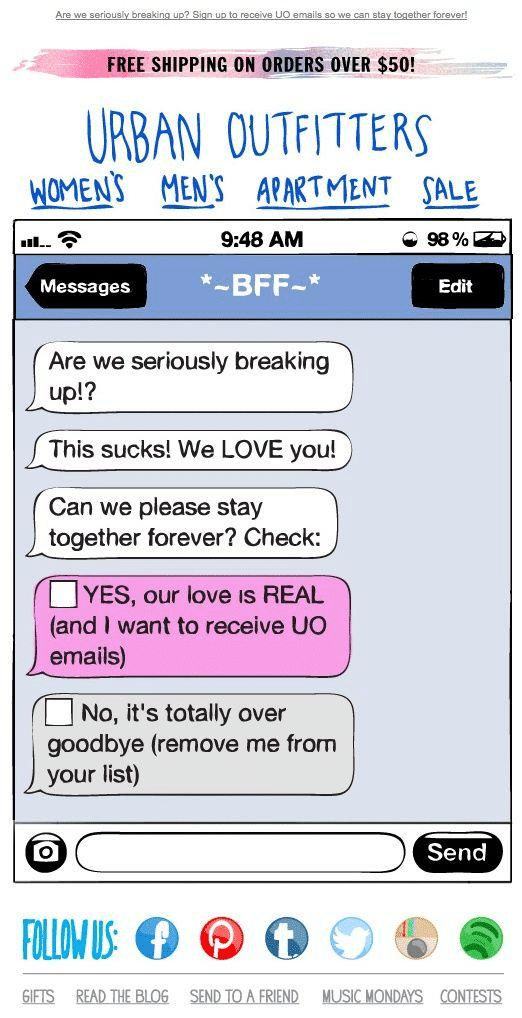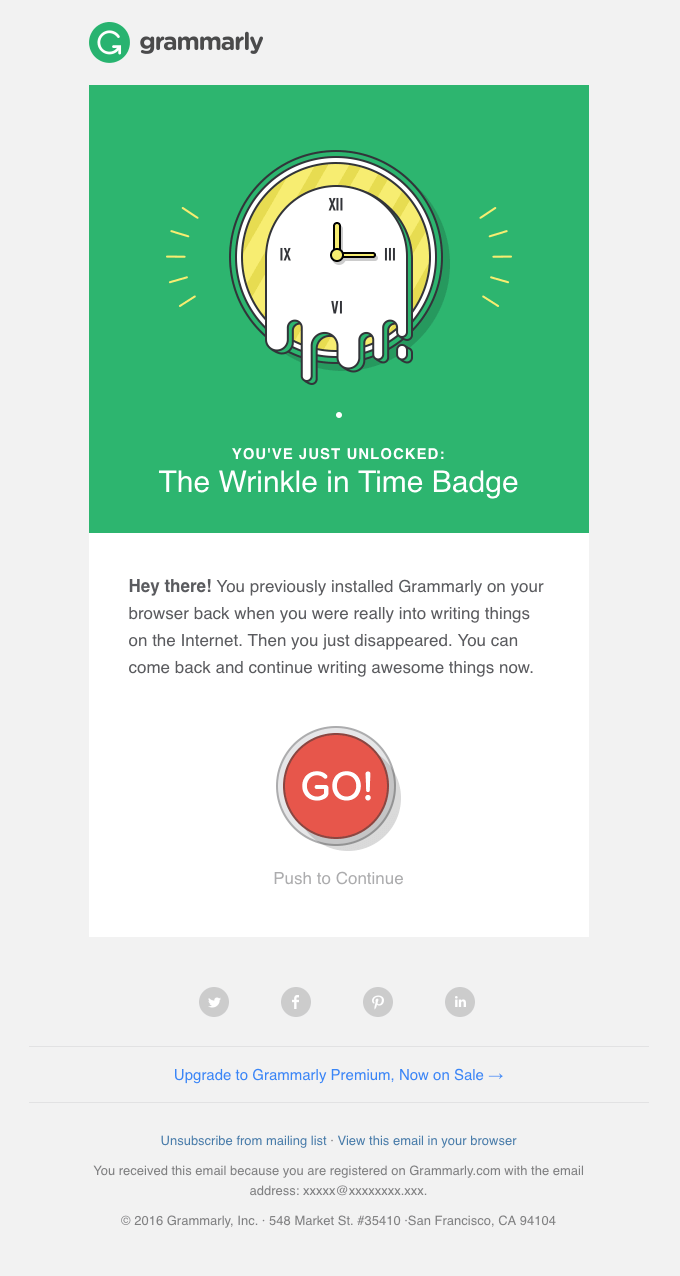Let’s be honest. People lose touch. In fact, if you have an email newsletter, you’ve probably also got a list of subscribers who have gone dormant. These are the folks who are either ignoring your emails altogether, or they simply aren’t clicking through.
According to Marketing Sherpa, you will lose around 22.5% of your list each year. It’s frustrating to lose customers when you work so hard to earn their email addresses in the first place. Fortunately, there is some good news. These customer relationships are not permanently lost—sometimes they are simply on a break.
And to get them back, you can reach out to them using effective re-engagement emails. To make this, you have to understand why they stopped connecting with you. Then, you can re-engage them with a customized approach.
Not everyone disengages for the same reason
A re-engagement email is a bit like asking an old flame to start dating you again. If you can’t prove that you understand their needs, you’re sunk. This is why generic emails never work. Before you move forward, you’ve got to figure out why they aren’t engaging.
Sometimes, there are clues. For example, someone who subscribed to get a special offer or gift might disengage after they received the goods. Dormant subscribers who have abandoned shopping carts might be displeased with your prices or check out process. You can even cross reference your CRM data with customer support logs
To see if you have inactive subscribers that have had complaints or other difficulties with your products.
Finally, take a look at your customer’s demographic information. if you notice a lot of people disengaging that have the same backgrounds, it’s pretty obvious that you aren’t meeting the needs of all of your customer segments.
Segment for more effective re-engagement
Re-engagement emails need to address two things First, you should the issues that led to them becoming inactive. Next, and more importantly, figure out what it takes to meet their needs now. This may be entirely different than what it was when they first subscribed.
Once this is done, you can begin to determine the best ways to re-engage these lost and inactive subscribers. Here are some approaches that may prove effective for you.
- Use frequent polls and surveys to measure user preferences.
- Reach out to inactive subscribers personally.
- Ask users who unsubscribe to provide a reason
You can also use data to connect inactive subscribers with other behaviors or factors. For example, match inactive users on your subscription list to customer service calls. you might be able to identify areas of frustration that are causing them to disengage from your brand.
It’s also a good idea to monitor your business online. If there’s something, whether true or not, that is damaging your reputation you could the seeing the impacts of that in lack of email engagement.
1. Ask the simple but obvious questions
Sometimes, the most effective re-engagement email is one that simply reaches out to the subscriber and asks them what is wrong or what you can do to meet their needs. Many people will appreciate this direct and sincere approach.
First, it gives them the opportunity to communicate their concerns to you. You can then use their feedback to improve the way you engage your customers in the future. It might look something like this.
Hi Steve,
We haven’t heard from you in a while. Is everything okay? We want to be sure our content meets your needs. In case you have concerns, we’ve included a link to a contact form below. You can also contact customer support 24/7.
Respectfully,
Jeff Davis, CEO, and Founder
2. Address concerns you know exist
Let’s be honest. Sometimes you know why your subscribers are pulling back. Maybe you had a product release go bad, or a PR disaster to contend with. It could even be something as simple as producing emails and newsletter content that aren’t up to standard.
If that’s the case, the best way to re-engage is to acknowledge, apologize without qualification, and detail how you plan to improve.
Rebecca,
We’re sorry. When you subscribed to our newsletter, you did so expect to get relevant content on eSports and related topics. Recently we have failed on those efforts. Several subscribers have complained that our emails have been too promotional and that we have missed several important news stories. our goal is to be a source of information first, and we haven’t done a very good job.
In the future, we will still tell you about our products and services. However, we will now Ensure that 90% of our newsletter content will be Esports news and information that you can use.
Sincerely,
Esports newsletter staff
3. Personalize with more than just a name
Let’s face it: Including someone’s name in a marketing, email is quite possibly the very least you can do.
Anyone can import a customer name from a spreadsheet or CRM database. to make customers feel true is as your email content is made from them and that you are interested in Meeting their needs, you have to personalize a deeper level.
Find ways to demonstrate that you understand each customer and want to meet their needs. mention their purchasing history. Consider segmenting email list further than you are currently. then create emails that specifically cater to each group individual preferences.
4. Engage with humor
In the right circumstances with a branding appropriate spin, humor can be an amazingly effective way to renew interest in your company. Just check out the email Urban Outfitters used to re-engage their subscribers.

It’s a light-hearted approach that likely served to remind customers that this is a fun brand to engage with. At the same time, it gives those who wish to unsubscribe a clear path to doing so.
5. Offer a giveaway
Of course, the purpose of reading engagement goes beyond getting folks to pay attention to your emails. You want them to engage with your brand across multiple channels.
Consider offering disengaged readers with the incentive to do just that. By offering a freebie in exchange for the reader taking a prescribed set of actions.
This can be as simple as asking them to click a link leading to A printable coupon, or adding their name to a drawing for free products in exchange for following you on social media.
Jamie Myers of Supreme Dissertations has a bit of warning about this, “Giveaways don’t re-engage customers in the long run. Only you can do that by creating great experiences. By all means, use this technique, but follow it up with something permanent and meaningful.”
6. Write interesting and professional content
A batch or two of sincerely or cleverly written emails isn’t sufficient. Both your email content and the on-site content that it leads to needs to be consistently relevant, informative, and well written. This is key to keeping leaders interested and to prevent churn in the first place.
Fortunately, there are many resources you can use for improving your content across all channels. Take a look at:
- Canva: This is a great tool for creating collages, picture clusters, infographics, and other visual content that make emails and landing pages more engaging,
- Grammarly: This is free, easy to use, and available on Chrome as well as for Word. Use it to check your grammar and eliminate embarrassing errors.
- Click to Tweet: This tool makes it easy for customers to engage with your content. Click to Tweet allows you to highlight a phrase for your audience to Tweet when they share your content.
- Hemingway: Engaging emails are designed to be easy and interesting reads. Hemingway will help you strip away the fluff and get right down to the good stuff.
- Idea Flip: This is a visual, brainstorming tool. If you have a writing idea, use this tool as a way to mold that idea into something useful.
7. Use gamification to re-engage subscribers
Gamification is an extremely effective marketing tool. It takes the elements of gaming and uses them in ways that aren’t necessarily related to playing games.
Examples of gamification include using badges or avatars, creating leaderboards, or offering challenges, such as challenging audience members to share a certain amount of content within a week.
Grammarly uses gamification in one if it’s re-engagement emails.

Here, they offer a ‘Wrinkle in Time’ badge to encourage readers to come back and begin using the product again.
8. Ungate content to renew interest
Christopher Mercer, business development manager at Citatior says, “If we notice high priority clients pulling away, we frequently reach out to them with previously gated content. It gives them a reason to stay in contact with us. It also allows us to get the most out of the content we work hardest to produce.”
There’s just one thing to keep in mind. If others have paid a premium of some sort to access that gated content, things can get a bit prickly if you simply turn around and give it away for free just to engage subscribers. It’s advisable to have a healthy waiting period before you release content for any reason.
Wrap up
Give subscribers options. Maybe they’re just not that into you anymore. Maybe they want something better. For some customers, it’s the length and frequency of your emails that are at issue.
No matter what, it’s important to know that email churn can be dealt with effectively. It’s just a matter of finding the best way to reach out to customers and get them back in the fold.





